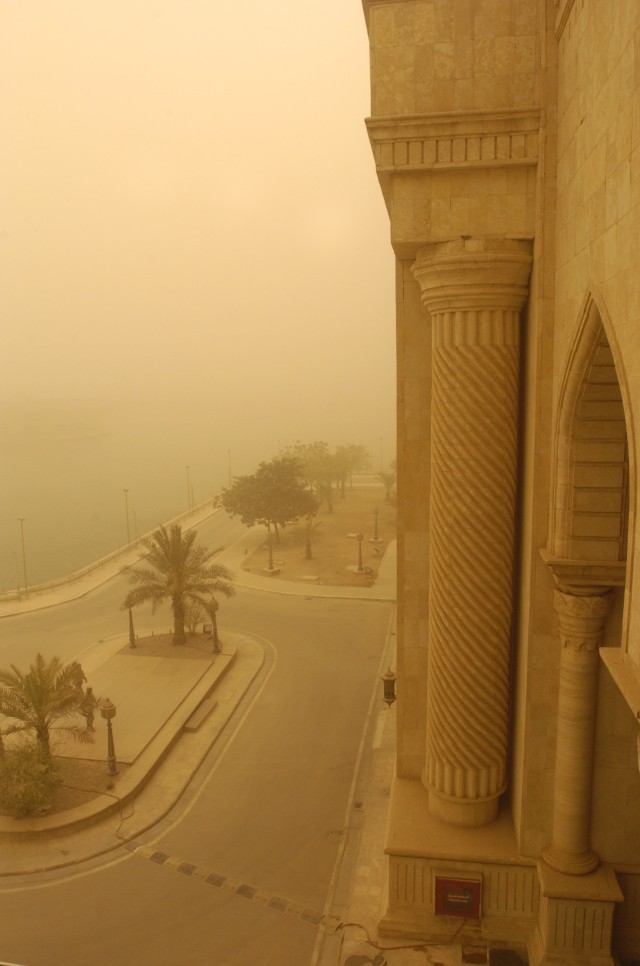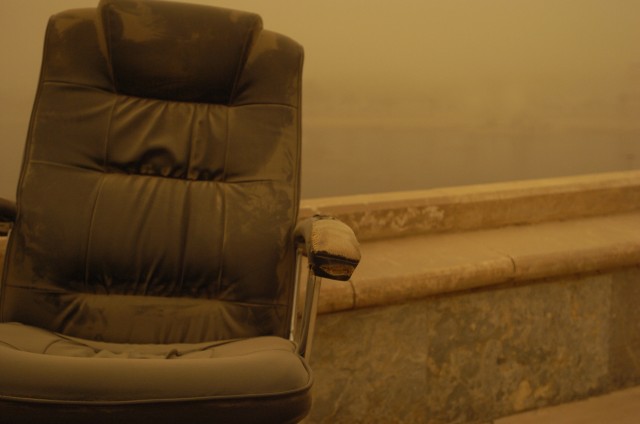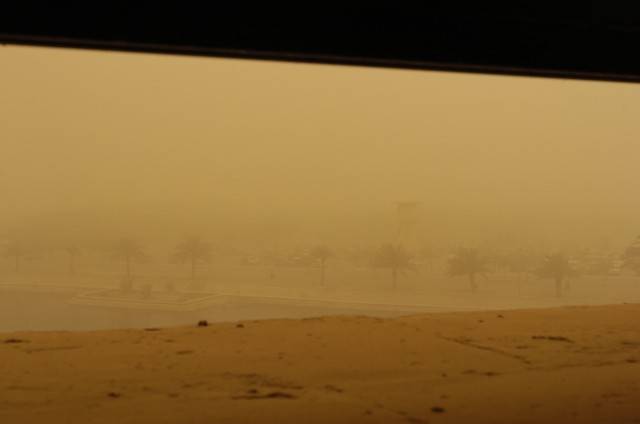CAMP VICTORY, Iraq - It gets in the hair, eyes and even the lungs. It piles up quickly on everything in sight, and it can even have an effect on day-to-day operations.
The 'it,' is dust, and Iraq is its breeding ground. When conditions are right, or wrong, that dust can become the monster that is known as the dust storm.
The dust that comprises a dust storm comes from what is known as dust source regions, which are abundant in Iraq. Dried lake beds or wetlands and the deserts in and around Iraq all play home to large amounts of dust. When the winds pick up, particularly above 15 knots (17.3 miles per hour), the dust gets picked up with it. If that wind speed sustains itself for a considerable amount of time, the dust storm is born, said Air Force Lt. Col. Jeffery M. Cox, a native of Piqua, Ohio, and chief of the Multi-National Corps - Iraq staff weather office.
"We have lots of fine dust that gets picked up by the winds here," Cox said, "and since it is so fine, it takes a while to settle down."
The SWO defines a dust storm as: "When visibility is less than 1000 meters, or 5/8 of a mile," Cox said.
And the dust storms have been happening a lot lately. Cox said there have been 18 days in May and June where dust storm conditions were experienced.
"That's about three times more than normal," he added.
The reason it has been happening more often than in previous years is due to an extreme drought - stemming from a very dry winter, also known as Iraq's wet season.
"In the winter, there is a wet season where we get several inches of rain in November, December and January," said Cox, a veteran of 19-plus years in the meteorology field. "What has happened this last fall is a very late start to the wet season. The first couple of months; October, November and December, we typically get a couple inches of rain each month. We didn't' get hardly any rain in October and November."
Iraq averages four inches of annual rainfall in the western and southern desert regions, and up to 40 inches of rain in the mountains of the northwest, according to www.globalsecurity.org.
Only a portion of that average occurred this past wet season.
"We actually received approximately 60 percent of the normal precipitation this winter," Cox said.
That means there are more dust storms this year because the drought has created "less vegetation to hold the ground together, so there is more dust, and there are more dried lake beds - which are great dust source regions because of the real fine silt," Cox said.
Once a dust storm gets brewing, it can last several days, Cox said, with less dust at night. And the height and breadth of a dust storm can be staggering.
On average a dust storm stays at 5,000 feet or less.
Recently, though, Cox said there was a dust storm in Northern Iraq which was up in the air at 18,000 feet.
"I've seen dust plumes big enough to cover the width of Iraq," he said. "Many times two-thirds of the country is covered by a major dust storm. That's not usual, but it can be huge."
And the dust that lingers in such storms can take a toll, both on equipment and human activity.
When it comes to equipment: "The more sophisticated an electrical system is, the more dust affects it," according to the United States' National Oceanic & Atmospheric Administration. "Dust compacts easily, solidifies with little added moisture and combines with lubricants - often resulting in clogged and/or jammed equipment and machinery. Dust and sand storms also set up electrostatic discharges that, while not typically fatal, can have negative consequences in fueling operations, computer or electrical systems."
As to the human element, medical personnel at the MNC-I surgeons office say the long-term risk from breathing dust in Iraq is thought to be low, however, they caution against performing strenuous activities when a dust storm is astir.
A medical safety alert posted in July from the surgeon's office states: "You can't breathe dirt. During exercise you breathe many times the volume of air (and dust) as when you are at rest. Your lungs have a natural process for expelling the fine particles that are inhaled, but until you get rid of the dust, your lung capacity is reduced."
While the less-than-healthy dust storms have a way of clogging lungs and machinery; they don't just sneak up on troops in order to do so.
"We do a pretty good job of predicting when dust storms are going to happen," Cox said.
Making sure troops know when dust is on its way are the 137 weather servicemembers in country. This includes two Polish meteorologists, four British, with the rest being U.S. servicemembers scattered around the country in 24 locations. Their main job during the summer is to predict dust storms, Cox said.
Once a dust storm is here though, it is closely monitored. The surgeon's office has preventive medicine personnel that test air quality and Soldiers exposed to extreme dust in order to monitor health effects.
And after it is gone, there will be people waiting for it to come once more. For the monster that is the Iraqi dust storm will be sure to rise again, but it can come and go knowing the staff weather and surgeons office at MNC-I will be monitoring its every move and side effect.






Social Sharing